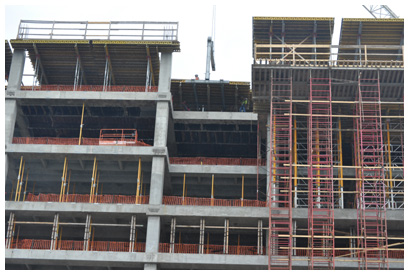PPIs remain mild; commercial construction looks solid, Wells Fargo says Editor’s note: Construction Citizen is proud to partner with AGC America to bring you AGC Chief Economist Ken Simonson's Data DIGest. Check back each week to get Ken's expert analysis of what's happening in our industry.
Editor’s note: Construction Citizen is proud to partner with AGC America to bring you AGC Chief Economist Ken Simonson's Data DIGest. Check back each week to get Ken's expert analysis of what's happening in our industry.
The producer price index (PPI) for final demand increased 0.2%, not seasonally adjusted (but fell -0.1%, seasonally adjusted), in February and 0.9% over 12 months, the Bureau of Labor Statistics (BLS) reported Friday. The PPI for final demand covers not only the prior headline PPI for finished goods (about 34% of total final demand), but also final demand services (64% of the total) and final demand construction (2% of the total). AGC posted an explanation and tables focusing on construction prices and costs. Construction is limited to five types of nonresidential buildings that BLS says make up 34% of total construction. Other building types, along with residential and nonbuilding construction, are not included. There are separate final demand indexes for private capital investment, government, personal consumption and exports, but only the first two are considered buyers of construction, since housing is not measured and buildings are not exported. The PPI for final demand construction rose 0.1%, not seasonally adjusted, in February and 3.2% over 12 months. The overall PPI for new nonresidential building construction – a measure of the price contractors say they would charge to put up a fixed set of five categories of buildings – increased 0.1% for the month and 3.4% since February 2013. The PPI for new warehouse construction (11% of the index for new nonresidential buildings) was flat in February and rose 2.6% over 12 months; offices (34% of the total), 0 and 2.9%, respectively; schools (26% of the total), -0.2% and 3.6%; health care buildings (16% of the total), 0 and 3.7%; and industrial buildings (13% of the total), 0 and 4.0%. The PPI for inputs to construction – an average of the cost of all materials used in construction plus items consumed by contractors, such as diesel fuel – rose 0.7% and 0.6%. Major construction materials with notable one- or 12-month price swings included gypsum products, for which the PPI jumped again in February, by 4.1% for the month and 11.6% year-over-year; insulation materials, 1.5% and 8.2%, respectively; lumber and plywood, 1.8% and 7.0%; diesel fuel, 4.4% and -6.0%; and copper and brass mill shapes, -1.5% and -6.8%. PPIs for new, repair and maintenance work on nonresidential buildings by plumbing contractors rose 0.6% and 4.5%; electrical contractors, 0.1 and 2.0%; roofing contractors, -0.1% and 1.7%; and concrete contractors, 0.3% and 1.7%.
Commercial construction “is ramping up across an increasing number of markets,” Wells Fargo Economics Group wrote in a commentary on Thursday. “Office [completions] more than doubled in 2013 and should post a larger gain this year….With [apartment] vacancy rates at cycle lows nationwide, fears about overbuilding, for the most part, appear to be premature. There is a great deal of construction in the pipeline…Net completions [of warehouses] remained fairly muted in 2013; however, the pipeline is growing. According to PPR, construction underway is twice the amount over last year and with the quick turnaround in building industrial space – roughly six months – the supply picture can change fairly quickly. Construction underway as a percent of stock remains well below the long-run average.” On February 25, Wells Fargo Equipment Finance reported that the 522 construction industry executives who responded to its 2014 Construction Industry Forecast “expressed strong optimism that local construction activity will increase in 2014 compared to 2013.”
“Last year, according to Census data, construction was started on a little less than one million new residential units, and about one in three of those was a rental in a multifamily building, the highest share since data began in the mid-1970s,” the Wall Street Journal reported on Tuesday. “The move toward apartment construction reflects the convergence of several trends. Mortgage credit is still tight. Also, Americans have seen muted wage gains, and others have high student-debt loads, forcing people who otherwise would have bought homes to rent instead. At the same time, as the job market improves, larger numbers of young adults are leaving their parents’ homes and forming their own households – adding more to the demand for rentals. And the supply of new apartments hasn’t kept pace, especially in some key markets such as San Francisco….That shorter-term growth in rental demand is combining with long-run demographic trends that are expected to continue to tilt U.S. home construction toward ‘multifamily’ units…Jordan Rappaport, an economist at the Federal Reserve Bank of Kansas City, projects that by the end of this decade, [multifamily units] are projected to increase to an annual rate of 550,000 new units a year, or roughly twice the rate of today.”
“Survey results indicate that employers expect hiring intentions to remain relatively stable during Quarter 2 2014 compared to Quarter 1 2014 and slightly increase compared to one year ago at this time,” Manpower Group stated last week in reporting on its latest quarterly survey of 18,000 U.S. employers. More employers expect to increase employment (19%) than to decrease it (4%) in all 13 sectors included in the survey. Relative to the first quarter, “staff levels are expected to remain relatively stable among employers in seven industry sectors,” including construction nationally and in the South. Construction employers “expect the hiring pace to slightly decrease” in the Midwest; to slightly increase in the Northeast; and to moderately increase in the West.
The Data DIGest is a weekly summary of economic news; items most relevant to construction are in italics. All rights reserved. Sign up at www.agc.org/datadigest.
AGC's Data DIGest: March 10 - 14, 2014
by Ken Simonson | March 17, 2014



Add new comment